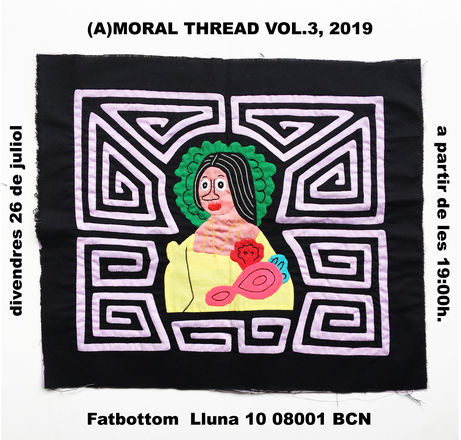


(A)moral Thread vol.3
(A)MORAL THREAD VOL.3, 2019
Curated by Nina Bačun and Juan Echeverry
In collaboration with Nuptidili Gonzales and Milton Santacruz and their family, members of the Gunadule community and the following artists:
Sharmila Banerjee
Birch Cooper
Antoine Eckart
Juan Echeverry
Dunja Janković
Adrienne Kammerer
Mario Kolarić / Sretan Bor
Amy Logheart
Power Paola
Juan Sebastián Rosillo
Mariah Scary
Nicolás Vizcaíno
(A)moral thread is a collaborative project that includes works of different artists from around the world. In previous two editions Željko Krašćić, a Croatian craftsman, reinterpreted the work of the artists into Zidnjaci (kitchen towels), a traditional Croatian embroidery.
In the new edition of (a)moral thread, we turn our attention to a different and more complex hand embroidery, Molas, made by the Guna tribe from San Blas Islands located on the border between Panama and Colombia.
Molas are embroidery pieces made out of two or more layers of fabric. These layers are cut, folded under, and sewn with a fine invisible seam to generate an image, as if it was a carving within the fabric. This technique is known as reverse appliqué. Appliqué refers to applying small layers of fabric sewn onto a larger piece to generate a specific design. In reverse appliqué the top layers have pieces cut out to make the base fabric visible.
Molas are a part of the traditional female costume of the Guna tribe. Each Mola has a pair. The two pieces are attached to the front and back of the female blouse. The craft and design is usually pursued by women or gay men, except for the traditional geometric designs which are elaborated from drawings made by the shaman or witch doctor of the tribe.
The traditional patterns found on Molas come from the geometric body painting that Guna women used as a protective charm. After Spanish colonisation and the appearance of missionaries, nakedness became sinful. Therefore these motifs went from the body of the woman to an underskirt, used as a protective garment for feminine sexuality. This garment was painted by the father of the girl with the arrival of menstruation. Later, the painted motifs were transferred to the top part of the garment which eventually transformed into Molas.
Besides geometric Molas, we find a variety of figurative designs, such as day-to-day activities, animals, plants and objects, as well as holiday imagery, political propaganda, television characters, advertisements and other pop culture references that have penetrated Guna culture. There is an important transformation in Molas.
Cultural colonization has turned Molas from being a mystical protective object to a communicative and decorative image. The absorption of pop culture and its subsequent distortion relates directly to our (a)moral aim.
The aim of (a)moral thread is to preserve and question tradition by entering a collaborative dialogue which connects artists with the Guna authors. We aim for a transformation where somebody’s ideas become somebody else’s material, where authorship is blurry and the final result is something that none of the parts had imagine.
Supported by Ministry of Culture of Republic of Croatia.
